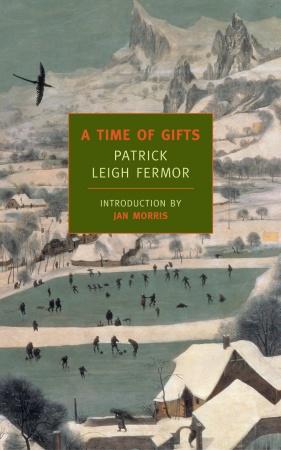I was a little hesitant to write about A TIME OF GIFTS by Patrick Leigh Fermor. The first in a densely written travel trilogy, this memoir includes long asides about Central European architecture, Greek philosophers, Proust, and the differences in wine glasses in different regions of Germany. I don’t care about wine or architecture. I care about Proust . . . but not enough to read him. What I’m saying is, don’t be afraid of this book because you don’t feel classy enough. You are classy! You are reading a literary blog!
Fermor might have his highbrow interests and a slightly archaic prose style, but, listen to this! It’s 1934, and our venerable Brit, age eighteen, is bumming around London after leaving school under less-than-highbrow circumstances. He decides to undertake an epic journey: to trek from the Netherlands to Istanbul (then called Constantinople). On foot. Alone. Oh, also, it’s the dead of winter.
See? Fermor is probably one of the most interesting people you could listen to talk about their vacation. He is, in addition to being a revered writer, a straight-up Indiana Jones–style war hero. During the Second World War, ten years after the journey that inspired A TIME OF GIFTS, he led a daring and successful mission to kidnap General Heinrich Kreipe, the Nazi commander of Crete. Also, he was pretty easy on the eyes.
So, anyway, this book. Fermor published A TIME OF GIFTS in 1977, and was working on the trilogy’s final volume, THE BROKEN ROAD, when he died in 2011 (it was published posthumously by New York Review Books in 2014). Despite the decades-long gap between the journey and the publication of his memoirs, the writing is fresh and exciting—not at all a dry memory of forgotten youth. Fermor relies heavily on the journals he kept at the time, but the prose itself captures an impressive amount of detail—little things that make the journey, which took place eighty-one years ago, seem close at hand. Observe how Fermor writes about the trudging across Germany on a very cold day:
“All was frozen. There was particular delight in treading across the hard puddles. The grey discs and pods of ice creaked under hobnails and clogs with a mysterious sight of captive air: then they split into stars and whitened as the spider-web fissures expanded.”
I felt that I was walking along with Fermor, seeing the clear sky and crumbling castles of the German countryside. Exhilarating.
Fermor made his audacious trip at a momentous time in European history. Hitler had just come to power in 1934, and his presence looms large as Fermor makes his way down the Danube. He is chronicling scenery that is about to be dramatically changed, and his trip is imbued a sense of tension, a dramatic irony. It’s difficult to read about Hungary and Prague without thinking about the approaching devastation of the Second World War. He is constantly meeting people who are so kind to him—farmers who let him sleep in their barn, barons who open their castle doors to him, two girls in Stuttgart who let him sleep over (gasp!) during a blizzard and pretend he’s a relative so he can come along to a fancy party. What happened to these lovely people? Did they make it through the impending destruction? Even writing from the 1970s, Fermor doesn’t always know.
But this book is a fun book, too—Fermor is a charismatic young man on the cusp of adulthood, prone to getting into sort-of-scandalous situations. He carouses with young ladies and alcohol is often involved (he writes of a ride with his two Stuttgart ladies, “we soared through a liquid city”). He easily connects with the people he meets on the road over their shared interests. He was voraciously curious about everything, and as he describes his encounters in pubs, drawing rooms and cafes across Central Europe, you can just picture him rhapsodizing with a fellow Shakespeare lover over the German translation of Hamlet, or the historical intricacies of the Thirty Years’ War. It’s so cute you can forgive him for going on a little bit.
Near the end, we are introduced to a wonder character, Baron Pips. He is in his fifties, handsome, rich, and well-lived. The Baron is the man who introduced Fermor to Proust. Fermor recounts the way the Baron would spin stories about Europe at the turn of the twentieth century while he listened on in wonder. Fermor writes, “I knew that his life had been full of movement and adventures.” By writing A TIME OF GIFTS, Fermor becomes the Baron—he has produced a sparkling memoir of interwar Europe in all its complication and splendor.







